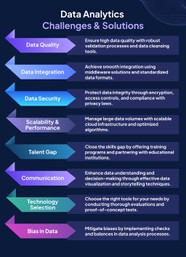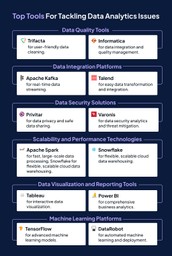Ready to tackle some common challenges in the world of data analytics?
Let’s dive in! But first, did you know that back in 2019, many businesses were already reaping the rewards of data analytics?
Yep, things like improved efficiency and productivity were becoming the norm, thanks to the power of data. But as with any journey, there were – and still are – hurdles to overcome.
That’s where taking a data analytics course comes into play!
Whether you’re just starting or looking to level up your skills, investing in an analytics course can provide you with the knowledge and tools you need to navigate the complexities of data analytics confidently.
So, let’s roll up our sleeves and explore how to conquer these data analytics challenges together!
How Data Analytics is Used by Different Professionals
Let’s explore how the magic of data analytics is woven into the fabric of various professions, transforming workflows and decision-making processes for the better.
From QA wizards to software developers and quality controllers, everyone’s tapping into the power of data.
- QA Maestros: Quality Assurance (QA) professionals leverage data analytics to unearth insights that drive quality improvements. By analyzing testing metrics, bug reports, and user feedback, QA teams can identify patterns, prioritize bug fixes, and optimize testing strategies for maximum efficiency.
- Software Sorcerers: Software developers harness the power of data analytics to inform their coding decisions and enhance user experiences. By analyzing user behavior data, performance metrics, and usage patterns, developers can fine-tune their applications, squash bugs, and deliver features that resonate with users.
- Quality Controllers: Quality controllers rely on data analytics to maintain product quality and compliance standards. By analyzing production data, defect rates, and quality metrics, controllers can identify areas for improvement, implement corrective actions, and ensure that products meet regulatory requirements.
- Business analysts are the architects of data-driven strategies. They use analytics to uncover actionable insights that drive business growth. Analysts can identify opportunities, mitigate risks, and optimize business processes for maximum profitability by analyzing market trends, customer behavior, and financial data.
- Marketing Gurus: Marketers leverage data analytics to craft targeted campaigns and maximize return on investment. Marketers can personalize messaging, optimize advertising spend, and drive conversions by analyzing customer demographics, engagement metrics, and campaigns. performance data.
- Healthcare Heroes: In the healthcare industry, data analytics plays a vital role in improving patient outcomes and operational efficiency. Healthcare professionals analyze data, treatment outcomes, and medical records to identify trends, personalize treatments, and streamline healthcare delivery.
- Financial Wizards: In the world of finance, data analytics is a game-changer for risk management, fraud detection, and investment strategies. Financial analysts analyze market data, transaction histories, and economic indicators to make informed decisions, mitigate risks, and maximize returns.
By embracing data analytics, professionals across various domains can unlock new insights, drive innovation, and stay ahead of their competition in a data-driven world.
Common Challenges in Data Analytics
Ah, the road to data enlightenment is not without its bumps and hurdles. Let’s shine a light on some of the common challenges that data analysts and professionals encounter along the way:
Data Quality and Integrity
Garbage in, garbage out – the age-old adage holds true in data analytics. Making sure the quality and integrity of data sources is paramount, as inaccuracies or inconsistencies can lead to misleading insights and flawed decisions.
Data Integration and Compatibility
Data often resides in disparate systems and formats, making integration and compatibility a daunting task. Aligning data from different sources, such as databases, APIs, and spreadsheets, requires careful planning and execution.
Is College
Worth It Anymore?
Data Security and Privacy
With great data comes ever great responsibility. Protecting sensitive information and making sure compliance with data privacy regulations (think GDPR and HIPAA) is a constant challenge for data professionals, especially in an era of increasing cybersecurity threats.
Scalability and Performance
As datasets increase in size and complexity, scalability and performance become critical concerns. Analyzing very large volumes of data in a timely manner requires robust infrastructure, efficient algorithms, and optimization techniques.
Lack of Skilled Talent
The demand for skilled data analysts and professionals far exceeds the supply, creating a talent gap in the industry. Finding and retaining qualified talent with expertise in data analytics, statistics, and programming can be a major challenge for organizations.
Interpreting and Communicating Insights
Extracting insights from data is only half the battle – effectively communicating those insights to stakeholders is equally important. Bridging the wide gap between data analysis and decision-making requires strong communication skills and storytelling abilities.
Tool and Technology Selection
The data analytics landscape is vast and ever-evolving, with a plethora of tools and technologies to choose from. Selecting the right tools for data storage, analysis, visualization, and machine learning can be overwhelming, requiring careful evaluation and experimentation.
Bias and Interpretation
Data analysis is susceptible to biases and subjective interpretations, which can skew results and lead to misinformed decisions. Identifying and mitigating biases, whether they’re inherent in the data or introduced during analysis, is essential for producing reliable insights.
Adapting to Rapid Technological Advances
The pace of technological innovation in data analytics is relentless, with new tools, techniques, and methodologies emerging rapidly. Keeping up with the latest advancements in collecting meaningful data requires continuous learning and professional development.
Navigating these challenges requires a combination of technical expertise, strategic thinking, and adaptability.
Solving Top Data Analytics Issues
Career Transition Toolkit
Now that we’ve identified some common challenges in data analytics let’s roll up our sleeves and explore potential solutions to overcome these hurdles.
With a bit of creativity and ingenuity, we can tackle these issues head-on:
Data Quality and Integrity
- Solution: Implement robust data validation processes and invest in data cleansing tools to identify and correct errors in your datasets. Create data governance policies and procedures to uphold data quality standards across the organization.
- Example: A retail company notices discrepancies in sales data between their point-of-sale system and online orders. By implementing automated data validation checks and regular audits, they identify and resolve inconsistencies, ensuring accurate reporting and analysis.
Data Integration and Compatibility
- Solution: Invest in data integration platforms and middleware solutions that streamline the process of combining data from different sources. Use standardized data formats and protocols to facilitate seamless data exchange between systems.
- Example: A healthcare provider integrates electronic health records (EHR) from multiple hospitals and clinics using a cloud-based data integration platform. By standardizing data formats and implementing secure APIs, they create a centralized repository of patient information for analysis and decision-making.
Data Security and Privacy
- Solution: Implement encryption, access controls, and data anonymization techniques to protect sensitive information. Moreover, conduct security audits and train employees on best practices for data security and privacy.
- Example: A financial institution enhances data security by encrypting customer data at rest and in transit. They implement multi-factor authentication for access to sensitive systems and conduct regular penetration testing to pinpoint and mitigate vulnerabilities.
Scalability and Performance
- Solution: Invest in scalable cloud infrastructure and distributed computing technologies to handle very large volumes of data efficiently. Optimize algorithms and queries for performance and parallel processing.
- Example: A social media platform leverages cloud-based data warehouses and parallel processing frameworks to analyze petabytes of user-generated content in real time. By optimizing their data pipelines and using distributed computing techniques, they ensure timely insights and responsive user experiences.
Lack of Skilled Talent
- Solution: Offer training programs, certifications, and mentorship opportunities to upskill existing employees on the data team and attract new talent. Invest in partnerships with educational institutions and industry associations to cultivate a pipeline of skilled data professionals.
- Example: A technology company launches an internal data academy to train employees in data analysis, machine learning, and data engineering. They also sponsor data science boot camps and offer tuition reimbursement for employees undertaking advanced degrees in data-related fields.
Interpreting and Communicating Insights
- Solution: Foster a culture of data literacy and communication within the organization. Provide training on data visualization, storytelling, and presentation skills to help data professionals effectively communicate insights to non-technical stakeholders.
- Example: A marketing agency equips its data analysts with storytelling workshops and presentation training to enhance their communication skills. They develop interactive dashboards and infographics to visualize key insights and engage clients in data-driven discussions.
Tool and Technology Selection
- Solution: Conduct thorough evaluations and proof-of-concept projects to assess the suitability of different tools and technologies for your specific use cases. Consider factors like ease of use, scalability, cost, and vendor support before making a decision.
- Example: A manufacturing company evaluates multiple business intelligence platforms before selecting one that offers advanced analytics capabilities, seamless integration with their existing systems, and a user-friendly interface. They also invest in training to ensure employees are proficient in using the selected tool.
By implementing these solutions and adapting them to your organization’s unique needs, you can overcome the top data analytics issues and unlock the full potential of data-driven decision-making.
Top Tools Used to Solve Analytics Issues
Let’s explore some of the top tools that data professionals rely on to tackle analytics issues and drive insights:
- Data Quality and Integrity Tools
- Trifacta: This self-service data preparation platform empowers users to clean, structure, and enrich their data without writing code, making it easier to ensure data quality and integrity.
- Informatica: Known for its data integration and quality management capabilities, Informatica offers a suite of tools to cleanse, standardize, and de-duplicate data across various sources.
- Data Integration and Compatibility Platforms
- Apache Kafka: Kafka is a distributed streaming platform that excels in handling real-time data streams. It enables seamless data integration and compatibility by acting as a central hub for data ingestion and processing.
- Talend: Talend provides an open-source data integration platform that simplifies the process of connecting and transforming data from disparate sources. Its graphical interface and pre-built connectors make it easy to integrate data across systems.
- Data Security and Privacy Solutions:
- Privitar: Privitar specializes in data privacy and protection, offering software solutions that enable organizations to safely use and share sensitive data while ensuring compliance with regulations such as GDPR and CCPA.
- Varonis: Varonis provides data security and analytics solutions that help organizations detect and prevent data breaches, insider threats, and cyberattacks. Its platform offers real-time visibility into data access and usage, allowing organizations to identify and mitigate security risks.
- Scalability and Performance Technologies:
- Apache Spark: Spark is a quick and general-purpose cluster computing framework that excels in processing large-scale data sets. It offers in-memory processing capabilities and support for distributed computing, making it ideal for handling big data analytics workloads.
- Snowflake: Snowflake is a data warehouse platform in cloud form that gives scalability, elasticity, and performance for analytics and data processing. Its special architecture separates computing and storage, allowing organizations to scale resources independently based on demand.
- Data Visualization and Reporting Tools:
- Tableau: Tableau is a data visualization and analytics platform that lets users create interactive dashboards and reports from their data. Its drag-and-drop functionality makes it easy for users to explore and communicate insights.
- Power BI: Power BI is a business analytics service by Microsoft that lets users visualize and share insights from their data. With features like natural language querying and AI-powered insights, Power BI makes it easy for organizations to derive actionable insights from their data.
- Machine Learning and Predictive Analytics Platforms:
- TensorFlow: TensorFlow is an open-source machine learning framework by Google. It gives a comprehensive ecosystem for building and deploying machine learning models, enabling organizations to utilize the power of AI for predictive analytics.
- DataRobot: DataRobot is an automated machine learning platform that eases the process of building, deploying, and managing machine learning models. Its user-friendly interface and automated workflows make it accessible to data professionals of all skill levels.
By leveraging these top tools and platforms, data professionals can address analytics issues more effectively and unlock new opportunities for insight and innovation.
Start Your Data Analytics Career with Syntax Technologies
Mastering data analytics is essential for organizations looking to drive insights and make more data-driven decisions in today’s fast-paced world.
By addressing common challenges, leveraging top tools, and staying abreast of industry trends, data professionals can see the full potential of data to drive innovation and competitive advantage.
At Syntax Technologies, our comprehensive courses cover a wide range of topics, including SQL, Python, and Power BI.
With expert-led training, hands-on projects, and personalized support, we’ll help you accelerate your data career and achieve your professional goals.
Don’t let challenges in data analytics hold you back.
Enroll now and start your journey towards data mastery!



